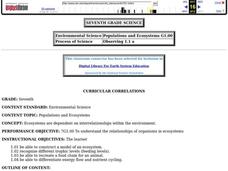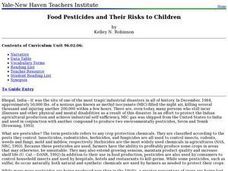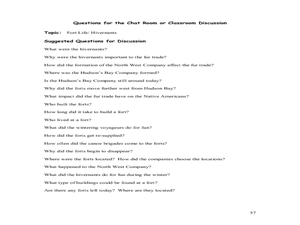Curated OER
Education for Global Peace
Learners survey the class and graph the results. In this graphing and data collection lesson, students conduct a survey to see where their shirts were produced. Individuals use software to graph the results and create a written...
Curated OER
Expressions and Operations
In this expressions and operations worksheet, 9th graders solve and complete 7 different problems that include reading and solving various types of equations. First, they determine the number of seconds it takes light from the sun to...
Curated OER
Bacteria in Your Life
In this bacteria worksheet, students conduct an experiment by looking through their cupboard and refrigerator at home and locating the expiration date on six foods. Then they record what they found in the table shown. Students also...
Curated OER
Chapter 13 – Progressivism
For this U.S. history worksheet, students read assigned textbook pages regarding Progressivsim and respond to 48 short answer questions.
Curated OER
Historical Indian Treaties and Aboriginal Population
Sixth graders navigate an online atlas of Canada and compare the land area of of historical Aboriginal peoples in Manitoba to present-day figures.
Curated OER
Estimation of Population Growth by Counting Offspring: Seed Multiplication
Students analyze a multi-seeded fruit, such as tomato, pepper, squash, watermelon, etc. They remove and count the seeds from the fruit and hypothesize/calculate the reproductive rate of that organism.
Curated OER
Hardy-Weinberg Equilibrium According to Hoyle: OR, Population Genetics or Platypapyrus foursuitii
Students use this exercise to help achieve a working knowledge of the Hardy-Weinberg Equilibrium without recourse to algebra. After participating in this activity, students gain a feeling for the significance of the Hardy-Weinberg...
Curated OER
Europe Puzzle
In this geography activity, students complete a crossword puzzle in reference to the geography of Europe. They identify the capital cities of various countries and the bodies of water which surround specific countries of Europe.
Curated OER
Proportional Rates
In this proportional rates worksheet, students read story problems, determine the necessary information, and identify a sequence of numbers at a specified time. This three-page worksheet contains three problems. The detailed answers...
Curated OER
Tracing Migration Patterns
Seventh graders analyze migration patterns. In this migration instructional activity, 7th graders use U.S. Census records to trace the migration patterns of 2 German families in Kansas.
Curated OER
Mapping Possible Solutions
Fourth graders propose possible sites for the heart of Florida state capital by mapping collected data onto a Florida state map and recording data in a Travel Log.
Curated OER
The Garber Family Letters: Recreating 19th-Century Family
Students interpret primary sources and recreate the story of the Garber family.
Curated OER
Six Billion and Beyond
Young scholars consider the idea of a world with Six Billion people and subsequent results and ramifications. Then students will gather data regarding the state of these diverse nations and then create a presentation as a culminating...
Curated OER
Populations and Ecosystems
Seventh graders create a model of an ecosystem and label it to show structure and function. They research the food web of an aquatic animal and also trace energy flow from the primary producer up the food chain.
Curated OER
Food Pesticides and Their Risks to Children
Students examine an industrial disaster in India which affected the food for generations to come. In groups, they research the history of pesticides and place them into groups based on the type of pests they control. They partcipate in...
Curated OER
A Tree Is More than a Street Name
Eighth graders discuss the role of trees as one of the most important natural resources. In groups, they examine how the forests nearby helped to shape their urban city. Using the internet, they research the use of the forest in early...
Curated OER
Population and resources(
Middle schoolers describe what a consumer is and give examples of how we affect the earth. They explain how we as consumers can change our actions to have less of an impact. Students discuss "How can we reduce the size of our footprint?"
Curated OER
The Biosphere
In this biosphere worksheet, learners identify the different levels of organization that ecologists study. Students complete charts, sentences, and answer short answer questions.
Curated OER
Civilization Pie
Students define civilization as it was in ancient times. In this world history lesson, students work in small groups to write a recipe that has all the combined ingredients of early civilized societies and share their results with...
Curated OER
Panther Scavenger Hunt
Learners research the Internet to fill out their scavenger hunt sheet. In this research lesson students search the Internet for answers to the questions on the scavenger hunt worksheet.
Curated OER
Stack #84201 Word Search
In this science worksheet, students locate and identify various vocabulary terms related to biology. There are fifteen words located in the puzzle to find.
Curated OER
Hivernants: The Wintering Voyageurs
Students research the history of fur posts in North America. In this North American history activity, students apply skills of historical interpretation by collecting and analyzing data from historic sources on the fur trade expansion.
EngageNY
Selecting a Sample
So what exactly is a random sample? The 15th part in a series of 25 introduces the class to the idea of selecting samples. The teacher leads a discussion about the idea of convenient samples and random samples. Pupils use a random...
LABScI
Genetic Equilibrium: Human Diversity
Investigate the Hardy-Weinberg Principle to explain genetic equilibrium. The 10th lesson plan of a series of 12 is a laboratory exploration of genetic equilibrium. Your classes use a mixture of beans to model allele and genotype...
Other popular searches
- Population Ecology
- Population Genetics
- Population Density
- Population Biology
- Population Growth
- Population Geography
- Human Population
- World Population
- Population Distribution
- Aging Population
- Populations and Ecosystems
- Human Population Growth























